
The chemistry of isatins a review from 1975 to 1999
.pdf
Please use CPS: orgchem/0010004 in any reference to this article
61
O |
|
|
O |
X |
|
|
|
|
|
O |
|
NH2 |
AcOH (X = O or S) |
N |
+ |
|
|||
|
or EtOH (X = O) |
|
||
N |
|
XH |
NH |
|
|
|
|
||
O |
|
|
O |
|
|
|
EtOH |
|
|
|
|
|
|
|
|
|
(X = S) |
|
|
|
N |
|
|
SH |
|
|
O NH |
|
|
|
|
S |
|
|
|
|
+ |
|
|
|
|
|
|
|
|
NH |
|
N |
|
|
|
H |
SH |
|
|
|
|
||
O |
|
|
NH |
|
|
|
|
|
|
|
|
|
O |
|
Scheme 78
Subsequent reports336338 on the reactivity of isatins towards o-aminothiophenol reported that isatin furnishes a benzothiazinone (18%), due to attack at the C-2 position, and a spirobenzothiazole (10%), due to attack at C-3, when the reaction is carried out in dry xylene in the presence of anhydrous ZnCl2 at room temperature. If the same reaction is carried out under reflux, the products formed are the benzothiazinone (20%), the spiro benzothiazole (40%) and an indolobenzothiazide (15%). 1-Acetylisatin, under the same reaction conditions furnishes, at room temperature, the corresponding ring opened product (20%), which can suffer deacetylation (15%), whereas under reflux these products (40 and 30%, respectively) are accompanied with the spiro compound (5%). 1-Methylisatin reacts only at reflux furnishing solely the spiro compound (42%) (Scheme 79).
This article is available from: http://preprint.chemweb.com/orgchem/0010004 Uploaded 17 October 2000 at 14:44 GMT
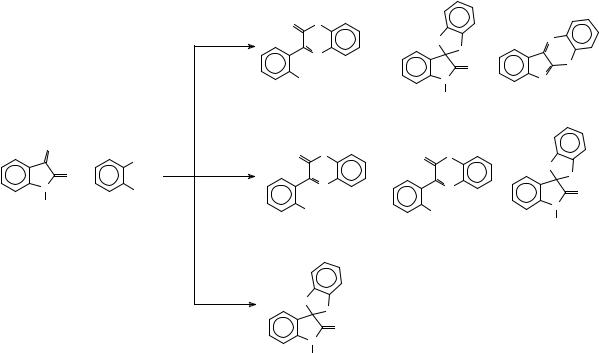
Please use CPS: orgchem/0010004 in any reference to this article
62
|
|
O |
S |
|
|
|
|
|
|
|
R = H |
|
|
HN |
|
|
N |
|
|
|
N |
+ |
S |
|
+ |
S |
|
|
|
|
|
O |
|
||
|
|
|
|
|
|
|
||
|
|
|
NH2 |
|
|
|
N |
|
|
|
|
|
N |
|
|
||
|
|
(20%) |
|
H |
|
|
(15%) |
|
|
|
|
(40%) |
|
|
|||
O |
NH2 |
O |
S |
|
O S |
|
|
|
|
|
|
|
HN |
||||
|
O + |
R = Ac |
|
|
|
|
|
|
|
|
N |
+ |
|
|
+ |
S |
|
N |
SH |
|
N |
|
O |
|||
|
|
|
|
|||||
R |
|
|
|
|
|
|
||
|
|
NHCOCH3 |
|
NH2 |
|
|
N |
|
|
|
|
|
|
|
H |
||
|
|
|
|
|
|
|
|
|
|
|
|
(20%) |
|
(15%) |
|
|
(5%) |
R = Me |
HN |
S
O
N
Me
(42%)
Scheme 79
The reactions of these compounds with o-aminophenol occur only at reflux. In the case of isatin, the formation of a ring opened product (25%) occurs along with the 3-imino derivative (30%), whilst 1-acetylisatin furnishes solely a ring opened product (48%). Characterisation of the products was based upon their mass, IR, 1H and 13C NMR spectra (Scheme 80).
This article is available from: http://preprint.chemweb.com/orgchem/0010004 Uploaded 17 October 2000 at 14:44 GMT
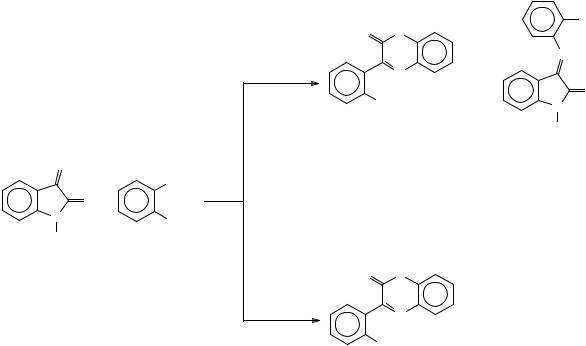
Please use CPS: orgchem/0010004 in any reference to this article
63
|
O |
O |
OH |
|
|
||
|
|
|
N |
|
R = H |
N |
+ |
|
|
||
|
|
NH2 |
O |
|
|
N |
|
|
|
|
H |
O |
|
(25%) |
(30%) |
NH2 |
|
|
|
|
|
|
|
|
O + |
|
|
N |
OH |
|
|
|
|
|
|
R |
|
|
|
|
O |
O |
|
|
R = Ac |
N |
|
|
|
NHCOCH3 |
|
(48%)
Scheme 80
The reaction of 5-fluoroisatin with o-aminophenol under the same conditions as the previous study was reported to result in the formation of a heterocyclic ring opened product and a nine membered ring compound. The isomeric 6-fluoroisatin was reported to furnish, apart from these two products, the corresponding 3-imine. The acetylated fluoroisatins behave similarly to 1-acetylisatin, giving rise to the ring opened product339 (Scheme 81).
This article is available from: http://preprint.chemweb.com/orgchem/0010004 Uploaded 17 October 2000 at 14:44 GMT

Please use CPS: orgchem/0010004 in any reference to this article
64
|
|
|
|
O |
O |
|
|
|
|
|
|
|
5-F |
F |
N |
+ |
N |
O |
|
|
|
|
|
|
|||||
|
|
|
|
|
|
||||
|
|
|
R = H |
|
|
F |
|
|
|
|
|
|
|
|
|
|
N |
|
|
|
|
|
|
|
NH2 |
|
N |
|
|
|
|
|
|
|
|
|
|
|
|
|
|
|
|
|
|
|
H |
|
|
|
O |
|
|
|
|
|
|
|
|
|
|
|
NH2 |
|
|
|
|
|
|
|
O + |
|
|
|
|
|
|
|
|
F |
N |
|
OH |
|
|
|
|
|
|
|
|
|
|
|
|
|
|
||
R |
|
|
|
|
|
|
|
|
|
|
|
|
|
|
|
|
|
|
|
|
|
|
|
O |
O |
|
|
|
OH |
|
|
|
|
|
|
O |
|
||
|
|
|
|
|
|
|
N |
N |
|
|
|
|
|
|
|
+ |
+ |
||
|
5-F or |
R = Ac |
6-F |
|
N |
|
|
||
|
|
|
|
|
|
||||
|
6-F |
|
R = H |
|
|
|
|
N |
O |
|
|
|
F |
NH2 |
|
N |
|||
|
|
|
|
F |
F |
N |
|||
|
|
|
|
|
|
|
H |
|
H |
|
O |
O |
|
|
|
|
|
|
|
N
F NHCOCH3
Scheme 81
3.3.1.2- Oxygen, sulfur and phosphorous nucleophiles
Isatin340 and 1-arylisatins341,342,343 suffer hydrolysis in alkaline solutions, leading to
isatinates. Kinetic studies have shown that this is a thermodynamically favored process, which also occurs under physiological conditions, implying that some, or all, of the biological and pharmacological activities described for isatins are indeed due to their isatinates344,345.
The pH profile for the hydrolysis of isatin has shown that at pH < 3, isatin is the predominant species, and at pH > 6, the ring opened isatinate is the major component. At pH values between 5 and 6, the rate of hydrolysis is first-order in hydroxide concentration or inversely proportional to the concentration of the hydronium ion, but from pH 6.5 to 10.5 it is pH independent. This result reveals the existence of a complex behaviour for the hydrolysis of isatin, with different rate limiting steps depending upon the pH of the solution. 346. A similar profile has been observed for 1-methylisatin347 (Scheme 82).
This article is available from: http://preprint.chemweb.com/orgchem/0010004 Uploaded 17 October 2000 at 14:44 GMT

Please use CPS: orgchem/0010004 in any reference to this article
65
O |
|
5 > pH > 6 |
O- |
|
|
H3O+ |
OH |
N |
|
H |
H |
O |
O |
|
|
|
|
O |
O- |
6.5 > pH > 10.5 |
|
|
|
|||
|
OH |
H2O |
||
N |
N |
|||
|
||||
H |
H |
|
|
|
|
|
|
10.5 > pH > 12 |
|
|
|
|
HO- |
CO2H |
CO2- |
O |
O |
NH2 |
NH2 |
O |
O- |
CO2- |
|
|
|
||
N |
O- |
O |
|
NH- |
|||
H |
|
Scheme 82
It was also observed that in the presence of ethanol and ethylene glycol the rate of hydrolysis decreases348. The effects of other solvents349, as well as the photophysics350 of the hydrolysis reaction of isatin have also been studied.
Isatinates can be electrochemically reduced to mandelates at different pH values using mercury electrodes351.
The isatinates can be converted to the corresponding oximes, which possess pharmacological interest as anti-inflammatory agents352.
Isatin-3-imines are hydrolyzed to isatin and the corresponding amine. A ring opened intermediate is proposed to be involved in the process as it was detected by polarography353.
The alkaline hydrolysis of isatin is the first step of a method for the construction of the indazolic ring system354. This method has been applied to the synthesis of serotonin antagonists355 (Scheme 83).
This article is available from: http://preprint.chemweb.com/orgchem/0010004 Uploaded 17 October 2000 at 14:44 GMT

Please use CPS: orgchem/0010004 in any reference to this article
66
O |
|
O ONa |
|
O |
NaOH |
O |
1. NaNO2 |
|
2. SnCl2 |
||
N |
|
||
|
|
||
H |
|
NH2 |
|
O ONa |
|
CO2H |
O |
(33%) |
N |
|
N |
|
|
|
|
NHNH2 |
|
H |
Scheme 83
Isatin-3-ketals are obtained by reaction with diols under homogeneous356 or heterogeneous acid catalysis, employing the strongly acidic resin Dowex 50X-X2357 or by transacetalation with trimethyl orthoformate358. 1-Acetylisatin reacts with alcohols in neutral media to furnish ring opened products228 (Scheme 84).
O |
|
|
O |
O |
|
|
|
||
|
|
O |
Ethyleneglycol, |
O |
|
|
p-TsOH |
||
N |
|
|
N |
|
|
|
|
||
R |
|
|
|
H |
|
O |
|
O |
OR |
|
|
|
|
O |
ROH |
O |
|
||
N |
|
NH |
|
|
|
O |
|
O |
|
|
|
|
Scheme 84 |
|
This article is available from: http://preprint.chemweb.com/orgchem/0010004 Uploaded 17 October 2000 at 14:44 GMT
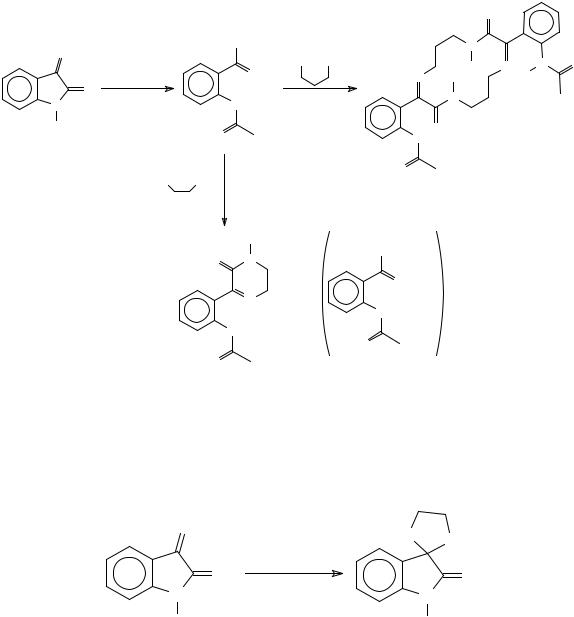
Please use CPS: orgchem/0010004 in any reference to this article
67
Bergman and Vallberg used the ethyl glyoxalate obtained by solvolysis of N- acetylisatin in refluxing ethanol to reinvestigate the reactions of N-acetylisatin with ethylenediamine and propane-1,3-diamine. The investigations were extended to a number of other diamines and the resulting dihydropyrazinones could be transformed to the corresponding pyrazidoindoles359 (Scheme 85).
CO2Et
O
NH2 NH2
O
O
N |
NH |
H
O
O
N
N H H N H N O N
NHO
O
H2N NH2
|
H |
CONHCH2 |
|
O |
N |
||
|
|||
|
|
O |
|
|
N |
+ |
|
|
|
NH |
|
NH |
O |
||
|
|
||
O |
|
2 |
|
|
Scheme 85 |
||
The reactions of isatins360,159 |
and |
1-alkylisatins361 with thiols yield substitution |
|
products at position C-3, such as isatin-3-thioketals and 3-alkylthiooxindoles362 (Scheme 86).
O |
|
S |
S |
|
|
|
|||
|
O |
(CH2SH)2 |
O |
|
N |
(80%) |
|||
|
N |
|||
|
|
|||
H |
|
|
H |
Scheme 86
This article is available from: http://preprint.chemweb.com/orgchem/0010004 Uploaded 17 October 2000 at 14:44 GMT
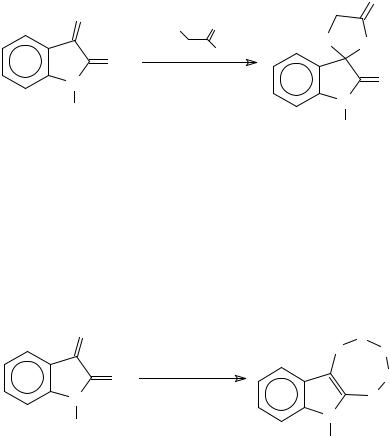
Please use CPS: orgchem/0010004 in any reference to this article
68
Isatin-3-N-arylimines react with mercaptoacetic acid to yield spirothiazolinones363
(Scheme 87). These can be further acylated or submitted to a Mannich reaction, thus giving products substituted at the oxindole nitrogen atom364.
NAr
O
N
H
HS O
OH (40-70%)
O
S NAr
O
N
H
Scheme 87
The addition of thiols to isatin anils to yield the respective thioazoketals is general365. The reaction of isatin with P4S10 in pyridine resulted in the obtention of
pentathiepino[6,7-b]indole136 (Scheme 88).
O |
|
S |
S S |
|
|
||
|
O |
P4S10 |
S |
|
Py |
||
N |
|
S |
|
|
N |
||
H |
|
|
|
|
H |
|
|
|
|
|
Scheme 88
Dialkylphosphites add to isatin and 1-substituted derivatives at position C-3 generating dioxindolophosphonates366. Isatin-3-oximes react in a similar manner367. The use of chlorophosphines generates 3-(3-clorooxindolyl) phosphine oxides368 (Scheme 89).
This article is available from: http://preprint.chemweb.com/orgchem/0010004 Uploaded 17 October 2000 at 14:44 GMT
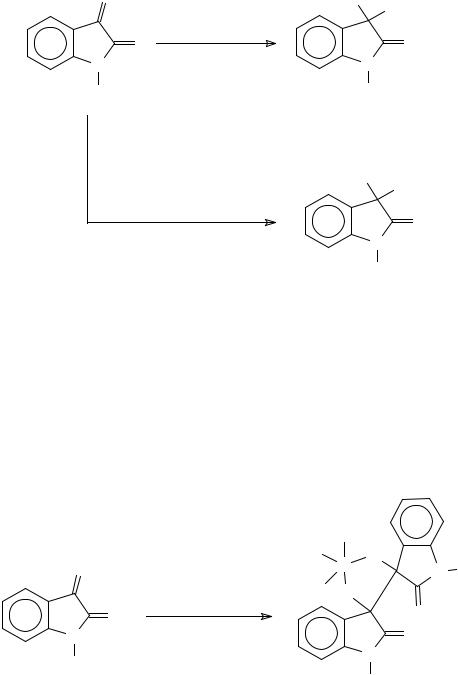
Please use CPS: orgchem/0010004 in any reference to this article
69
O |
|
HO |
PO(OR)2 |
|
|
|
|
O |
(RO)2POH |
|
O |
(70-87%) |
|
||
N |
|
N |
|
|
|
||
R |
|
|
R |
|
Cl |
POΦ 2 |
|
|
|
(Φ O)2PCl |
|
O |
(30-71%) |
|
|
|
N |
|
|
|
|
|
|
R |
Scheme 89
On the other hand, cyclic dioxaphospholanes369, phosphites370 and trialkyl phosphites371,372 react with isatins to yield dimeric spiro phospholanes (Scheme 90). Cyclic indolic phosphates were obtained when 1-methylisatin was reduced with sodium in THF to yield a dianion that subsequently reacted with alkyl phosphorodichloridates373 (Scheme 91).
O
O
N
R
(RO)2PR' (35-80%)
OR RO P O
N R
R' O
O
O
N
R
Scheme 90
This article is available from: http://preprint.chemweb.com/orgchem/0010004 Uploaded 17 October 2000 at 14:44 GMT
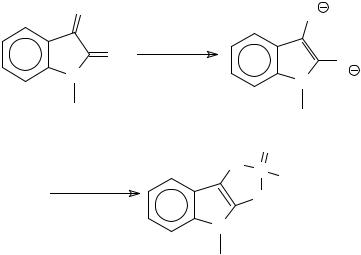
Please use CPS: orgchem/0010004 in any reference to this article
70
O |
O |
O |
Na/THF |
O |
|
N |
N |
Cl2P(O)OR
(52-64%)
O
O P OR
O
N
Scheme 91
Isatin-3-N,N-dimethylhydrazone when reacted with diethyl phosphonate, furnishes isatin-N-ethyl-N,N-dimethyl hydrazonium ethyl phosphonate374.
The reaction of isatin with triphenylphosphine was believed to furnish indirrubin375, but a reinvestigation of this reaction has shown that the products formed are 3- triphenylphosphoranylideneoxindole and isoindigo376.
4.3.3 - Carbon nucleophiles
Carbon nucleophiles add to isatin and derivatives at position C-3 in most cases, and the products formed have been submitted to further transformations giving rise to a variety of heterocyclic systems.
Potassium cyanide and ammonium carbonate react with 1-alkyl377 or 1- alkenylisatins363 generating spirohydantoins. These compounds are inhibitors of the enzyme aldose reductase, and have potential use as hypoglycemic agents (Scheme 92).
This article is available from: http://preprint.chemweb.com/orgchem/0010004 Uploaded 17 October 2000 at 14:44 GMT
